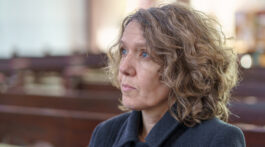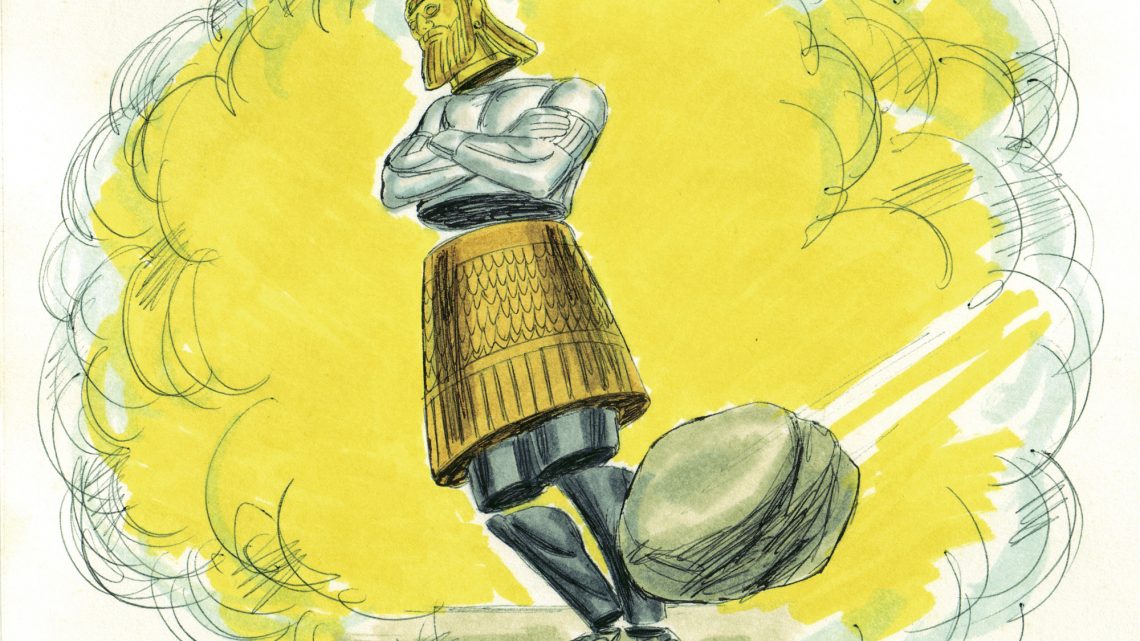Sabbath School Lesson for January 11-17, 2020
Overview
Chapter 2 of Daniel brings us many insights about God…
- His immanence, or presence, is felt in our world, as evidenced by the king’s dream (Sunday)
- He appreciates our prayers of thanksgiving and praise that follow a request (Monday)
- He allows Daniel to share the forgotten dream with the king (Tuesday)
- He gives Daniel the interpretation of the dream (Wednesday)
- He refers to Himself as the stone in the dream, and gives us a glimpse of the coming Kingdom of God (Thursday)
Introduction
There is no chance for us misinterpreting Nebuchadnezzar’s dream in chapter two. Once Daniel has revealed it to the king. Daniel, himself, gives the interpretation that he received from God; and history has clearly seen its fulfillment over the centuries.
This single chapter has brought many people to a sense of who God is, building their faith to the point of feeling like God really does care about our lonely world. From the time of the Babylonian, Medo-Persian, Grecian, and Roman empires, the image in the king’s dream has been accurately portrayed. It’s easy to see ourselves in the toes of the image–waiting for the stone to smash it and fill the earth with His everlasting Kingdom.
What began as a hopeless pursuit to answers that none of the wise men of Babylon could provide soon became one of the greatest prophecies of all time.
Daniel and his friends had only recently completed their training in the court. They were included in the executions that the king had decreed since no one seemed able to tell what his dream was. Once again, Daniel’s friends poured out their hearts to God, and God answered their prayers. Now, they just had to convince the king that they had the answers he was seeking.
Memory Text: “Daniel answered and said: ‘Blessed be the name of God forever and ever, to whom belong wisdom and might’ “ Daniel 2:20 ESV
How it must have thrilled Daniel’s heart when he first received the dream and the interpretation. He rightly gives God all the glory for this great mystery turning into such a powerful revelation.
Sunday: The Immanence of God
Isaiah prophesied about the Messiah saying, “Therefore the Lord Himself will give you a sign: Behold, the virgin shall conceive and bear a Son, and shall call His name Immanuel.” Isaiah 7:14 And, of course, Matthew translates the meaning of the name as “God with us.” (Matthew 1:23)
Therefore, when we talk about the immanence of God, we are talking about His presence in our everyday world. The dream given Nebuchadnezzar definitely proved that God is with us, in all aspects of life. He actually provides the undercurrent that moves the rise and fall of nations.
The human will, unpredictable and changing, is like the wind, blowing our lives this way and that. But God is the main driving force in human events. History has provided us with evidence for our faith in the prophecy that was revealed to Daniel.
As a side note, we are somewhat confused to find that the dream occurs “in the second year of Nebuchadnezzar’s reign”, because we were also informed in Daniel 1:5 that there would be three years of training for the young captives. It does appear that Daniel and his friends are fully recognized as wise men in the palace, as they are included in the execution order of the king. So, how do we explain this seeming contradiction.
Some Bible scholars tell us that the first year of a king’s assenccion was usually not counted as the first year of his reign. Therefore, the second year of Nebuchadnezzar’s reign would have been three years previously, allowing three years for Daniel to be fully trained and accepted into court.
Discussion Questions:
Read Daniel 2:1-3, 11. Did God purposely cause the king to forget his dream, and for what purpose? Why did it anger the king so, when his wise men failed to tell him the dream?
Read Daniel 2:9. How does this verse show that Nebuchadnezzar had some doubts about their abilities before this test? What, or who, might have given him some information about the true God of heaven?
Read Daniel 2:5, 6. How would this offer of such opposite rewards have terrorized the wise men of the palace? And how does it show the desperation of the king to know the meaning of his forgotten dream?
Monday: The Prayer
Daniel doesn’t record their pleas to God for the answer to the king’s questions about the dream. He does express the prayer of thanksgiving that followed their request, however.
Jesus emphasized the importance of our thankfulness to God. Our heavenly Father rejoices when we remember to thank Him for all His goodness in our life. The story of the ten lepers who were healed, and the one who came back to thank Him, illustrates the joy God receives from our praise and appreciation of His bountiful mercies.
We can always count on God to hear our prayers and answer them in the best way for everyone. He may not remove our trials, but He’s always there to give us strength to endure them.
Discussion Questions:
Read Daniel 2:22-23 and Hebrews 4:13. Why was it important to thank God for revealing the dream? How easy would it have been for Daniel to become proud of his prophetic abilities, and how do all of us stay away from this kind of pride for our accomplishments?
Read Luke 17:15-19. What does our faith have to do with our thankfulness?
Read Psalm 138:3 and 23:3, 4. How does prayer benefit us, even if we aren’t given the precise thing we were asking for?
Tuesday: The Image, Part 1
God had obviously intervened in giving Daniel the dream and its meaning. With some trepidation, however, Daniel then faced the prospect of relaying God’s message in a way that wouldn’t further anger the highly volatile monarch. The prospect of the king losing his throne to other powers would not be a welcome prospect for the king to consider.
We sense God’s wisdom throughout Daniel’s discourse with Nebuchadnezzar, as the humble servant tactfully lays out the meaning of the dream, being careful to equate his Babylonian empire as representing the head of gold, a kingdom of “power, strength, and glory”.
The other kingdoms, represented by inferior metals, must have appealed to the monarch. He seemed to take the message well, rewarding Daniel profusely when the interpretation was over.
We are left in awe, after hearing about this dream, knowing how accurate the predictions have proven to be. We look back on history and see that kingdoms and empires would come and go, just as Daniel portrayed them.
Discussion Questions:
Read Daniel 2:27, 28 and Genesis 41:15, 16. Why was it kings, in both these instances, who received such important dreams that only God could reveal and interpret?
Read Daniel 2:31-34. What might have seemed most dramatic and troubling about the dream to Nebuchadnezzar, after Daniel refreshed his memory about what the dream was about?
Read Hebrews 11:15, 16. Why should we constantly keep our focus on our heavenly home, especially in these last days? What then should be our focus in the dream Daniel interprets for the king?
Wednesday: The Image, Part 2
The prophecy in chapter two is a general outline of historical events, with more details about world governments given in Daniel’s later visions. Seeing the fulfillment of the kingdoms described in this image, however, is an important way to build our faith in what’s in store for these latter days.
The outline extends down to the end of time, when the stone destroys the image representing the kingdoms of this world. It is therefore apocalyptic in nature, and not conditional, as many previous prophecies have been. There is nothing man can do to prevent these empires from establishing their power structures.
Here are the kingdoms described in the dream:
- Head of gold = Babylon in 626-539 B.C. (The Bible calls it “the golden city” in Isaiah 14:4–also remember that gold and other precious metals was mentioned in Revelation 18:16.)
- Chest and arms of silver = Medo-Persia in 539-331 B.C. (The Persians used silver in their taxation system.)
- Belly and thighs of bronze = Greece in 331-168 B.C. (They were noted for their bronze armor.)
- Legs of iron = Rome in 168 B.C.-476 A.D. (aptly fits the crushing power and long-lasting nature of this empire)
- Feet, partly of iron and clay from 476 A.D. to the Second Coming (represents the divided nations of the world today)
Discussion Questions:
Read Daniel 2:38, Isaiah 14:4, and Revelation 17:4, 5. What kind of kingdom does Babylon represent in later prophecies? How does its gold deceive those who are under its rule?
Read Daniel 2:39-43. What are some other earthly governments that have tried and failed to forge world empires since Rome’s day, but never reached the scope of these four ancient kingdoms? What might the coming of the Messiah have had to do with this lack of a true empire since the days of Christ?
Read Daniel 2:35 and Zechariah 4:6. How does God rule? Why isn’t it based on might or on power?
Thursday: The Stone
The most dramatic scene of this image dream has to be the stone, cut without hands, that was hurled at the image, shattering it into pieces as fine as chaff.
The stone, representing God, is a a widely-accepted metaphor in the Bible, and may even be a reference specifically to the Messiah. Some have therefore mistakenly interpreted the event, the setting up of God’s Kingdom, as happening during the first century, when Christ first came to earth.
Daniel 2:44, however, says this new Kingdom will consume all the previous world kingdoms, even the divided ones, and will stand as a great mountain forever. This has obviously not happened, as we still see nations striving to be number one, without any lasting Kingdom established.
Revelation thankfully portrays a New Jerusalem that will come down out of heaven after the Second Coming of Jesus, when this Kingdom prophecy will most likely find its entire fulfillment. We, therefore, have much to look forward to, with the Kingdom of God waiting in the portals to fill our earth with lasting peace and love.
Discussion Questions:
Read Daniel 2:35 and Revelation 16:14. How might these two verses be describing the same event?
Read Deuteronomy 32:4, 1 Corinthians 10:4, and 1 Peter 2:4, 7. What characteristics about God remind us of a stone? How do these verses place God the Son and God the Father as equals?
Read Revelation 21:2-4. How is God’s Kingdom different from what we find on earth now, and how does verify that the final event of Nebuchadnezzar’s dream is still in our future?
Final Thoughts
The most important message we can take from this chapter, indeed from the whole book of Daniel, is found in the prayer of thankfulness, recorded by Daniel after this enormous revelation of the king’s dream. He was prompted to write these words…
“Blessed be the name of God forever and ever, for wisdom and might are His. And He changes the times and the seasons; He removes kings and raises up kings; He gives wisdom to the wise and knowledge to those who have understanding. He reveals deep and secret things; He knows what is in the darkness, and light dwells with Him.” Daniel 2:20-22 NKJV
The panoramic view of history foretold in the king’s forgotten dream also increases our faith in this all-powerful God of the universe. Today, after seeing its predictions fulfilled so accurately, we should be even more confident in the Lord we serve.
This confidence in God’s power should hold true in our individual lives as well. We often feel circumstances spiral out of control, or at least they feel that way to us. The chaotic times we live in only seem to magnify what we are experiencing.
But let’s remember where the source of all true wisdom and understanding come from. The peace we are seeking is always available because God has promised to be with us to the end (Matthew 28:20). The culmination of events that occur at and after the Second Coming may be all we have to live for. But it’s a reward worth waiting and dying for.
Let’s pray as Christ taught us, “Thy kingdom come, thy will be done on earth as it is in heaven” Matthew 5:10, and think of that stone in the dream.
Next Week’s Lesson: From Furnace to Palace
To read the Sabbath School Lesson Quarterly or see more resources for its study, go to https://www.absg.adventist.org/
Other Outlook blogposts by Teresa Thompson, are at http://outlookmag.org/author/teresathompson/










